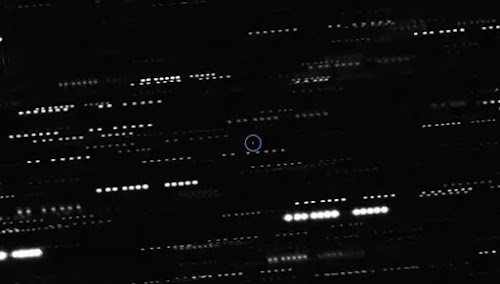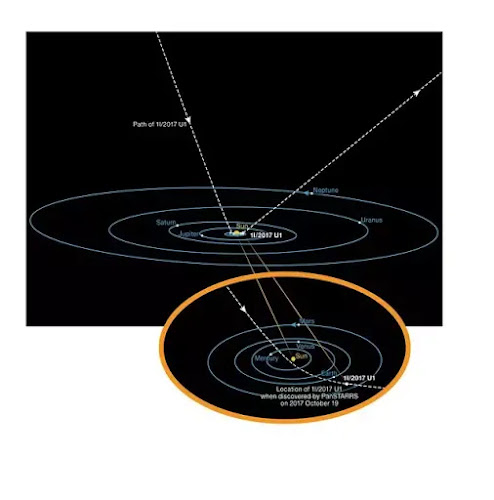Mystery and facts revealed about Oumuamua | First interstellar object | Information about Oumuamua Asteroid
The Universe consists of billions of galaxies, stars,
planets, asteroids and other celestial objects. Our own solar system consists
of millions of asteroids and comets in which most of them are yet to be
discovered. But in 2017, one strange asteroid visited our solar system and
travelled billions of kilometres to reach us.
On 19 October 2017, astronomer Robert Weryk discovered an
asteroid moving towards the Sun using Pan-STARRS1 telescope, Haleakala
Observatory in Hawaii. At first, he thought that it was a comet and on 6
November 2017, a team of astronomers concluded that it was an asteroid. They
named it as “Oumuamua”, designated as “1I/2017 U1”. Oumuamua means "a
messenger from a far arriving first" in Hawaii. Astronomers detected
Oumuamua on 19 October 2017, but no one traced Oumuamua when it entered into
solar system.
 |
| Oumuamua_Into_the_dark_space Image credit: ESO/M. Kornmesser https://www.eso.org/public/images/eso1737a/ |
As of we know, from past 2000 years not even a single
celestial object entered into solar system. Oumuamua is the first interstellar
object ever noticed by us. Scientists and astronomers made estimations on
Oumuamua, said "Oumuamua entered into our solar system on 9 September 2017
and we didn't detected it, until it reached near to the Sun on 19 October, 2017
".
Oumuamua is travelling in a hyperbolic path, and when Robert
Weryk discovered Oumuamua, it is at a distance of about 33 million kilometres away
from us, which is 85 times the distance between the Earth and moon.
 |
| Image_of_Oumuamua_Into_the_dark_space Image credit: ESO/K. Meech et al. https://www.eso.org/public/images/eso1737b/ |
Oumuamua has size in between 100 to 1000 meters and from
estimations, it is about 400 meters in size. Commonly, asteroids and comets in
our solar system contains water or ice above their surface, but Oumuamua
doesn't have any sort of these signs. Strangely, Oumuamua is made up of
different kind of metal, has different shape ( in 1:10 ratio) and dark reddish
in colour, which is so different than the asteroids in our solar system. So,
some scientists and astronomers called Oumuamua as ‘Alien spacecraft’, because
of its strange properties.
At first we discovered Oumuamua, it is travelling at a
blistering speed of 87 kilometres/sec and completing its rotation in 7.2 hours. When
we discovered it, it is travelling far away from the Sun into the interstellar
space. But until December 2017, we observed it and later it disappeared due to
its small size, so we can't detect it. Finally, Scientists and astronomers
concluded that it will flung away into interstellar space in between first few
months of 2018.
 |
| Oumuamua_orbit_Into_the_dark_space Image credit: Credit: ESO/K. Meech et al. https://www.eso.org/public/images/eso1737c/ |
Some facts to know about Oumuamua are,
We don't know exactly where it come from but as we consider
it's direction, it came from the star Vega in the constellation of Lyra. Star
Vega is 25 light years away from us, meaning Oumuamua travelled thousands of
years in interstellar space to reach us.
It travelled closer to the Sun at about 20 million kilometres,
which is nearer than Mercury's orbit and amazingly, it escaped from Sun's
gravity pull. Oumuamua is small in size, when compared to other asteroids,
making hard to detect. If it is trapped by the Sun's gravity pull, then the
speed of Oumuamua will decrease to 20 kilometres/sec and if it is the case, then it will
reach the interstellar space in 2020.
Astronomers said, there is no harm to Earth from Oumuamua
asteroid and if it hit Earth, then the world would have already ended in 2017. What do you think?
Share your ideas and thoughts in comment section below.
For more information click here and for updates please follow my site,
Thank you.
Really selection of topics was osm.... Evariki thelenavi rasthunaru... Good keep going
ReplyDeleteThank you for ur support.
DeleteGood information bruh...
ReplyDeleteThank you.
DeleteTopic was awesome
ReplyDeleteThank you.
DeleteWay to go crowning achievement in Dark space
ReplyDeleteHaha thank you for ur support.
DeleteNice one
ReplyDeleteGood Content 👌...Keep It Up Guys
ReplyDeleteThank you.
DeleteAwesome
ReplyDeleteThank you.
DeleteReally good information..... Provide many..
ReplyDeleteSure, Thank you.
DeleteVery good keep going
ReplyDeleteSure, thank you.
DeleteAmma baboyi.mind block
ReplyDeleteHaha, thank you.
DeleteGood 👍 content is osm👌
ReplyDeleteThank you.
DeleteGreat info
ReplyDeleteThank you.
DeleteLoved the content ❤️
ReplyDeleteThank you.
DeleteI am not sure what is really going on in this today's blog post, but as a fellow space maniac I can see that it's about an asteroid which came from a constellation called 'LYRA' and 'VEGA' is the brightest star present in that constellation. But because Vega is the brightest star that can be seen in the Lyra constellation. Did physicists say that this asteroid is from VEGA? Just a doubt though.
ReplyDeletePeace☮
Peace☮
Not sure, they can only made some estimations to know the direction. We don't know the exact location where it come from, so we can only make some computer simulations by calculations made and can know the direction.
DeleteTopic selection is really good..!!! Keep going and let others also know the facts which are have to be known...
ReplyDelete#goodproject #historymatters🔥
Thank you for ur support.
DeleteGood ! Keep it up !
ReplyDeleteThank you.
DeleteGood one.
ReplyDeleteBut it's hard to spell "Oumuamua".
Haha your right.
Deleteits good to see students trying om different concepts and exploring themselves... hope you come up with more interesting topics... good!
ReplyDeleteSure, Thank you.
DeleteNice work
ReplyDeleteNice
ReplyDeleteExcellent work 👍
ReplyDeleteThank you.
DeleteIt is intersting topics have in it nice
ReplyDeleteExcellent super👌👌👌
Thank you.
DeleteNice work
ReplyDeleteThank you.
DeleteGreat one
ReplyDeleteThank you.
DeleteInteresting....
ReplyDeleteGood one.. keep going
ReplyDeleteThank you.
DeleteImpressive
ReplyDeleteIt's good
ReplyDeleteNice dude
Thank you.
DeleteGood work.nice one😍
ReplyDeleteThank you.
DeleteValuable information 🔥
ReplyDeleteThank you.
DeleteIntresting...
ReplyDeleteThank you.
DeleteGood information
ReplyDeleteThanks.
DeleteGood Content 👌
ReplyDeleteThank you.
DeleteSuperb....nice info😉
ReplyDeleteThank you.
DeleteNice information annaya
ReplyDeleteThank you bro.
DeleteGood content
ReplyDeleteGood content
ReplyDeleteThanks.
Deletematter KEKA
ReplyDeleteNice...
ReplyDeleteThanks.
DeleteExcellent content
ReplyDeleteKeep doing you are excellent
ReplyDeleteThank you.
DeleteFirst I didn't know anything about the topic but after reading I got to know lot of information it is very clear cut and very well explained
ReplyDeleteThank you for ur support.
DeleteThanks.
ReplyDelete